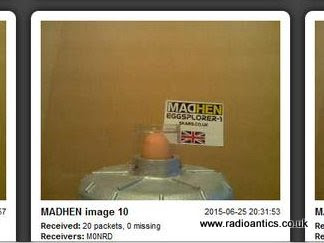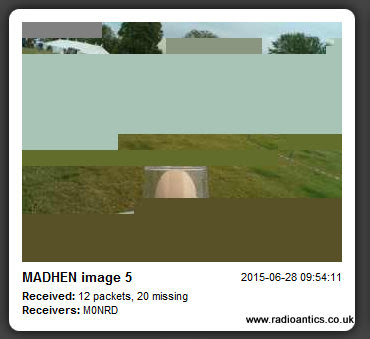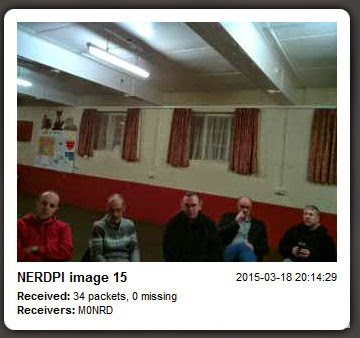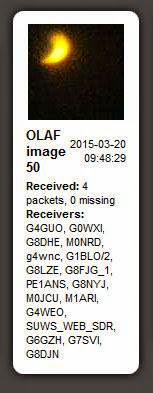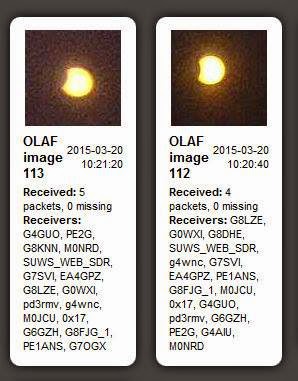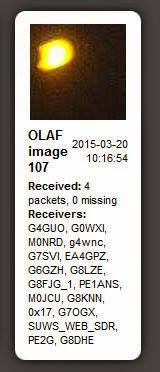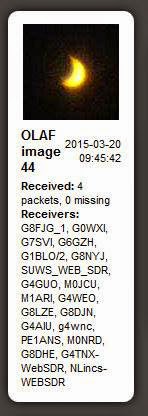Posts Tagged ‘ukhas’
 First HAB flights were a success
First HAB flights were a success
Two years after discovering the hobby of High Altitude Ballooning I have migrated from being just a passive tracker and finally completed my first flights assisted by other members of the South Kesteven ARS.
Back in March I posted about the opportunity I had to make a launch at this years Swaton Vintage Day and the 10th World Egg Throwing Championship
South Kesteven ARS were going to hold a special event station with the call sign GB2EGG. During the planning stage I jokingly suggested throwing an egg in to space on board a balloon, I shouldn't have yoked...
The whole venture captured everyone's imagination, sadly putting the special event station in the shade but we certainly got a lot of publicity for the club and amateur radio in general.
There was certainly a lot to learn and get organised, not only did I have to design and build the flight computer which was the easy part but I had to build the payload containers get the balloon, parachute, cord the lifting gas (Helium) and build a filler assembly as well as getting official permission from the CAA for the launch.
The information on the UKHAS wiki as well as Dave Akerman's High Altitude Ballooning, From The Ground Up (and back again) were invaluable.
The cost of this venture was not insubstantial and thankfully MADHEN - The Ultimate Party Band agreed to sponsor the flight which helped greatly and I received a nice donation from fellow club member Mark Orbell (M0OBL)
Months of work and lots of last minute hitches but I was ready.
Two flights were planned an altitude 'burst' flight with a raw egg payload with a parachute decent. The main tracker MADHEN would broadcast SSDV images and telemetry with a telemetry backup tracker EGG1 suspended below it. The second flight was a foil party balloon 'floater' with a tracker kindly donated by Steve Smith G0TDJ of ProjectAVR
Both flights flew and were a great success, unfortunately the SSDV tracker failed early in the flight so no in flight images were received.
The main payload is pictured below before the flight resting on its side. The Styrofoam box contained the flight computer and radio transmitter with a camera attached to the Raspberry Pi and the "flying saucer" model which contained the egg was positioned to be visible.
As this test image shows the 'egg saucer' should have had the earth below it.
However the arduino based backup tracker which was suspended below it worked perfectly.
There were some issues with getting CAA approval because the sky was very busy on the day including the last remaining Vulcan Bomber VH-558 making its farewell flight in the area, cue jokes about the Vulcan getting scrambled... but approval was given for a morning flight, not ideal for the organisers but we were still a spectacle for the handful who were there early.
It started so well, I was receiving telemetry and image packets and then transmission stopped
However as I said the other tracker worked brilliantly and this was the final flight path as visualised in Google Earth. The ascent and decent rate and the burst altitude were exactly as planned and predicted, so I know I got the neck lift measurement right even with the high wind on the day.
A splashdown at sea was inevitable due to the wind conditions, hopefully it it survived the landing it may wash up on a beach somewhere and we can retrieve the images.
With what little Helium remained I was able to lightly fill and launch a foil party balloon carrying a blown egg shell as a 'floater' which made a valiant attempt to reach the continent at 6-7km high travelling at 120+km/hr where it reportably hit bad weather and was downed.
All in all an eggscellent day!
| Ready to launch |
South Kesteven ARS were going to hold a special event station with the call sign GB2EGG. During the planning stage I jokingly suggested throwing an egg in to space on board a balloon, I shouldn't have yoked...
The whole venture captured everyone's imagination, sadly putting the special event station in the shade but we certainly got a lot of publicity for the club and amateur radio in general.
| Featured on front page of local paper |
There was certainly a lot to learn and get organised, not only did I have to design and build the flight computer which was the easy part but I had to build the payload containers get the balloon, parachute, cord the lifting gas (Helium) and build a filler assembly as well as getting official permission from the CAA for the launch.
The information on the UKHAS wiki as well as Dave Akerman's High Altitude Ballooning, From The Ground Up (and back again) were invaluable.
The cost of this venture was not insubstantial and thankfully MADHEN - The Ultimate Party Band agreed to sponsor the flight which helped greatly and I received a nice donation from fellow club member Mark Orbell (M0OBL)
Months of work and lots of last minute hitches but I was ready.
Two flights were planned an altitude 'burst' flight with a raw egg payload with a parachute decent. The main tracker MADHEN would broadcast SSDV images and telemetry with a telemetry backup tracker EGG1 suspended below it. The second flight was a foil party balloon 'floater' with a tracker kindly donated by Steve Smith G0TDJ of ProjectAVR
Both flights flew and were a great success, unfortunately the SSDV tracker failed early in the flight so no in flight images were received.
The main payload is pictured below before the flight resting on its side. The Styrofoam box contained the flight computer and radio transmitter with a camera attached to the Raspberry Pi and the "flying saucer" model which contained the egg was positioned to be visible.
As this test image shows the 'egg saucer' should have had the earth below it.
However the arduino based backup tracker which was suspended below it worked perfectly.
There were some issues with getting CAA approval because the sky was very busy on the day including the last remaining Vulcan Bomber VH-558 making its farewell flight in the area, cue jokes about the Vulcan getting scrambled... but approval was given for a morning flight, not ideal for the organisers but we were still a spectacle for the handful who were there early.
| Starting the fill |
| Checking the neck lift, made difficult by the wind |
| Stewart (M0SDM) helping me tie off the balloon and payload cord |
| The strong gusty wind made launch difficult |
| Me and Stewart making a dash to assist the launch |
Someone was on hand to capture it on video for The World Egg Throwing Federation
It started so well, I was receiving telemetry and image packets and then transmission stopped
However as I said the other tracker worked brilliantly and this was the final flight path as visualised in Google Earth. The ascent and decent rate and the burst altitude were exactly as planned and predicted, so I know I got the neck lift measurement right even with the high wind on the day.
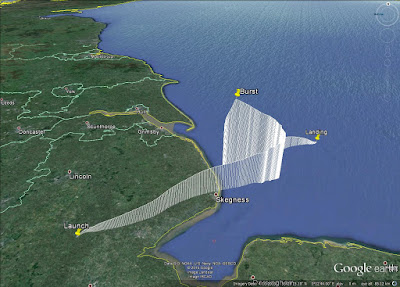 |
| Path of MADHEN/EGG1 |
A splashdown at sea was inevitable due to the wind conditions, hopefully it it survived the landing it may wash up on a beach somewhere and we can retrieve the images.
With what little Helium remained I was able to lightly fill and launch a foil party balloon carrying a blown egg shell as a 'floater' which made a valiant attempt to reach the continent at 6-7km high travelling at 120+km/hr where it reportably hit bad weather and was downed.
 |
| Path of EGGDX in comparison to MADHEN/EGG1 |
All in all an eggscellent day!
 First HAB flights were a success
First HAB flights were a success
Two years after discovering the hobby of High Altitude Ballooning I have migrated from being just a passive tracker and finally completed my first flights assisted by other members of the South Kesteven ARS.
Back in March I posted about the opportunity I had to make a launch at this years Swaton Vintage Day and the 10th World Egg Throwing Championship
South Kesteven ARS were going to hold a special event station with the call sign GB2EGG. During the planning stage I jokingly suggested throwing an egg in to space on board a balloon, I shouldn't have yoked...
The whole venture captured everyone's imagination, sadly putting the special event station in the shade but we certainly got a lot of publicity for the club and amateur radio in general.
There was certainly a lot to learn and get organised, not only did I have to design and build the flight computer which was the easy part but I had to build the payload containers get the balloon, parachute, cord the lifting gas (Helium) and build a filler assembly as well as getting official permission from the CAA for the launch.
The information on the UKHAS wiki as well as Dave Akerman's High Altitude Ballooning, From The Ground Up (and back again) were invaluable.
The cost of this venture was not insubstantial and thankfully MADHEN - The Ultimate Party Band agreed to sponsor the flight which helped greatly and I received a nice donation from fellow club member Mark Orbell (M0OBL)
Months of work and lots of last minute hitches but I was ready.
Two flights were planned an altitude 'burst' flight with a raw egg payload with a parachute decent. The main tracker MADHEN would broadcast SSDV images and telemetry with a telemetry backup tracker EGG1 suspended below it. The second flight was a foil party balloon 'floater' with a tracker kindly donated by Steve Smith G0TDJ of ProjectAVR
Both flights flew and were a great success, unfortunately the SSDV tracker failed early in the flight so no in flight images were received.
The main payload is pictured below before the flight resting on its side. The Styrofoam box contained the flight computer and radio transmitter with a camera attached to the Raspberry Pi and the "flying saucer" model which contained the egg was positioned to be visible.
As this test image shows the 'egg saucer' should have had the earth below it.
However the arduino based backup tracker which was suspended below it worked perfectly.
There were some issues with getting CAA approval because the sky was very busy on the day including the last remaining Vulcan Bomber VH-558 making its farewell flight in the area, cue jokes about the Vulcan getting scrambled... but approval was given for a morning flight, not ideal for the organisers but we were still a spectacle for the handful who were there early.
It started so well, I was receiving telemetry and image packets and then transmission stopped
However as I said the other tracker worked brilliantly and this was the final flight path as visualised in Google Earth. The ascent and decent rate and the burst altitude were exactly as planned and predicted, so I know I got the neck lift measurement right even with the high wind on the day.
A splashdown at sea was inevitable due to the wind conditions, hopefully it it survived the landing it may wash up on a beach somewhere and we can retrieve the images.
With what little Helium remained I was able to lightly fill and launch a foil party balloon carrying a blown egg shell as a 'floater' which made a valiant attempt to reach the continent at 6-7km high travelling at 120+km/hr where it reportably hit bad weather and was downed.
All in all an eggscellent day!
| Ready to launch |
South Kesteven ARS were going to hold a special event station with the call sign GB2EGG. During the planning stage I jokingly suggested throwing an egg in to space on board a balloon, I shouldn't have yoked...
The whole venture captured everyone's imagination, sadly putting the special event station in the shade but we certainly got a lot of publicity for the club and amateur radio in general.
| Featured on front page of local paper |
There was certainly a lot to learn and get organised, not only did I have to design and build the flight computer which was the easy part but I had to build the payload containers get the balloon, parachute, cord the lifting gas (Helium) and build a filler assembly as well as getting official permission from the CAA for the launch.
The information on the UKHAS wiki as well as Dave Akerman's High Altitude Ballooning, From The Ground Up (and back again) were invaluable.
The cost of this venture was not insubstantial and thankfully MADHEN - The Ultimate Party Band agreed to sponsor the flight which helped greatly and I received a nice donation from fellow club member Mark Orbell (M0OBL)
Months of work and lots of last minute hitches but I was ready.
Two flights were planned an altitude 'burst' flight with a raw egg payload with a parachute decent. The main tracker MADHEN would broadcast SSDV images and telemetry with a telemetry backup tracker EGG1 suspended below it. The second flight was a foil party balloon 'floater' with a tracker kindly donated by Steve Smith G0TDJ of ProjectAVR
Both flights flew and were a great success, unfortunately the SSDV tracker failed early in the flight so no in flight images were received.
The main payload is pictured below before the flight resting on its side. The Styrofoam box contained the flight computer and radio transmitter with a camera attached to the Raspberry Pi and the "flying saucer" model which contained the egg was positioned to be visible.
As this test image shows the 'egg saucer' should have had the earth below it.
However the arduino based backup tracker which was suspended below it worked perfectly.
There were some issues with getting CAA approval because the sky was very busy on the day including the last remaining Vulcan Bomber VH-558 making its farewell flight in the area, cue jokes about the Vulcan getting scrambled... but approval was given for a morning flight, not ideal for the organisers but we were still a spectacle for the handful who were there early.
| Starting the fill |
| Checking the neck lift, made difficult by the wind |
| Stewart (M0SDM) helping me tie off the balloon and payload cord |
| The strong gusty wind made launch difficult |
| Me and Stewart making a dash to assist the launch |
Someone was on hand to capture it on video for The World Egg Throwing Federation
It started so well, I was receiving telemetry and image packets and then transmission stopped
However as I said the other tracker worked brilliantly and this was the final flight path as visualised in Google Earth. The ascent and decent rate and the burst altitude were exactly as planned and predicted, so I know I got the neck lift measurement right even with the high wind on the day.
 |
| Path of MADHEN/EGG1 |
A splashdown at sea was inevitable due to the wind conditions, hopefully it it survived the landing it may wash up on a beach somewhere and we can retrieve the images.
With what little Helium remained I was able to lightly fill and launch a foil party balloon carrying a blown egg shell as a 'floater' which made a valiant attempt to reach the continent at 6-7km high travelling at 120+km/hr where it reportably hit bad weather and was downed.
 |
| Path of EGGDX in comparison to MADHEN/EGG1 |
All in all an eggscellent day!
 Eggciting HAB projects
Eggciting HAB projects
I have a new high altitude balloon project, this one is very Eggciting.
In June my club South Kesteven Amateur Radio Society (SKARS) will be operating a special event station at the Swaton Vintage Day held at Thorpe Latimer in Lincolnshire.
The 2015 Swaton Vintage Day will also host the 10th World Egg Throwing Championship and in recognition the special event station will have the call sign GB2EGG. This popular annual show raises money for local, national and international good causes.
Egg Throwing is recognised by the English Sports Council and the sport is taken very seriously by some competitors. Hundreds of competitors from Europe and around the world are expected to compete this year. Last year’s event attracted teams from Germany, Slovenia, Hong Kong and Brazil.
While planning the special event station I jokingly suggested throwing an egg in to space on board a balloon, I shouldn't have yoked as it is now a serious project. The idea coming from Dave Akerman's Spudnik flight for Heston Blumenthal’s Channel4 television program.
Subject to Civil Aviation Authority clearance and weather conditions I will hopefully launch a high altitude balloon carrying one lucky egg into the edge of space and then dropping it back to earth under a parachute. In addition to the plucky Eggstronaut the balloon I have called Eggsplorer-1 will carry a radio transmitter to broadcast its position, altitude and live images of the journey back to earth.
On board cameras will record the journey to be recovered on a successful return to Earth. Radio enthusiasts all around the country will be able to assist receiving the data and pictures and track the progress of the flight via the UK High Altitude Society tracking website.
More details and progress will be posted on here and on the Eggsplorer-1 website and you can follow developments on twitter @eggsplorer1South Kesteven ARS welcomes anybody with an interest in radio communications, so if want to be involved in this and other events like this please visit us at the show or visit the South Kestevan ARS website and on twitter @M0SKR
I have already begun development of the payload, unlike the moth-balled NERD-1 payload this one will use one of the Raspberry Pi boards since I want to transmit SSDV images live and it supports its own specially designed camera modules. NERD-1 will still fly as a backup tracker.
Dave Akerman (M0RPI) and Anthony Stirk (M0UPU) have developed the Pi-In-The-Sky ready made boards and the design and software are open-sourced, using this as a starting point together with Phil Heron's (MI0VIM) SSDV software I quickly had a prototype dubbed NERDPI running.
I did have an issue since the GPS module I currently have only outputs serial data so had to use one of those small TTL USB-Serial adapters and spun some of my own code to get the data out and was soon successfully decoding my own transmissions from the shack and uploading them to the Habhub system.
Today has seen the spectacular partial solar eclipse here in the UK, during the eclipse several HAB flights were launched to try to capture images above any cloud cover (details here) Fellow SKARS members and members from the Grantham ARC were keen to decode the SSDV images themselves as the BBC Stargazing Live balloons were flying from nearby Leicester.
So on Wednesday I did a talk and demonstration to show how to track and decode the images, it was well received and I uploaded pictures of the audience to the system.
Unfortunately technical issues prevented live images from the Stargazing HABs being transmitted but I was able to decode some images from the University of Southampton OLAF payload They were only lo-res but still pleased to get decodes here it was a good distance from me.
Here in Newark the sky was beautifully clear so the eclipse was visible and spectacular, where OLAF was flying was covered in cloud, so the mission was a success.
In June my club South Kesteven Amateur Radio Society (SKARS) will be operating a special event station at the Swaton Vintage Day held at Thorpe Latimer in Lincolnshire.
The 2015 Swaton Vintage Day will also host the 10th World Egg Throwing Championship and in recognition the special event station will have the call sign GB2EGG. This popular annual show raises money for local, national and international good causes.
Egg Throwing is recognised by the English Sports Council and the sport is taken very seriously by some competitors. Hundreds of competitors from Europe and around the world are expected to compete this year. Last year’s event attracted teams from Germany, Slovenia, Hong Kong and Brazil.
While planning the special event station I jokingly suggested throwing an egg in to space on board a balloon, I shouldn't have yoked as it is now a serious project. The idea coming from Dave Akerman's Spudnik flight for Heston Blumenthal’s Channel4 television program.
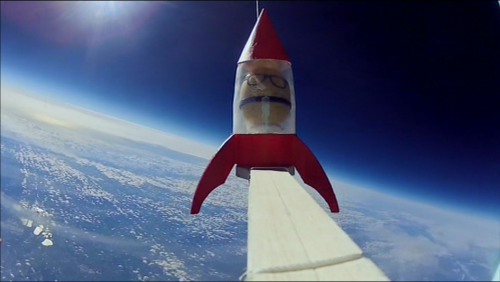 |
| Image with the permission of Dave Akerman |
On board cameras will record the journey to be recovered on a successful return to Earth. Radio enthusiasts all around the country will be able to assist receiving the data and pictures and track the progress of the flight via the UK High Altitude Society tracking website.
More details and progress will be posted on here and on the Eggsplorer-1 website and you can follow developments on twitter @eggsplorer1South Kesteven ARS welcomes anybody with an interest in radio communications, so if want to be involved in this and other events like this please visit us at the show or visit the South Kestevan ARS website and on twitter @M0SKR
I have already begun development of the payload, unlike the moth-balled NERD-1 payload this one will use one of the Raspberry Pi boards since I want to transmit SSDV images live and it supports its own specially designed camera modules. NERD-1 will still fly as a backup tracker.
Dave Akerman (M0RPI) and Anthony Stirk (M0UPU) have developed the Pi-In-The-Sky ready made boards and the design and software are open-sourced, using this as a starting point together with Phil Heron's (MI0VIM) SSDV software I quickly had a prototype dubbed NERDPI running.
I did have an issue since the GPS module I currently have only outputs serial data so had to use one of those small TTL USB-Serial adapters and spun some of my own code to get the data out and was soon successfully decoding my own transmissions from the shack and uploading them to the Habhub system.
Today has seen the spectacular partial solar eclipse here in the UK, during the eclipse several HAB flights were launched to try to capture images above any cloud cover (details here) Fellow SKARS members and members from the Grantham ARC were keen to decode the SSDV images themselves as the BBC Stargazing Live balloons were flying from nearby Leicester.
So on Wednesday I did a talk and demonstration to show how to track and decode the images, it was well received and I uploaded pictures of the audience to the system.
Here in Newark the sky was beautifully clear so the eclipse was visible and spectacular, where OLAF was flying was covered in cloud, so the mission was a success.
 Grantham ARC HAB Talk
Grantham ARC HAB Talk
Yesterday I gave my talk and demonstration at the Grantham Amateur Radio Club on High Altitude Ballooning and tracking.
This follows on from the South Kesteven ARS (SKARS) and the Spalding and District ARS (SDARS) talks I gave in May
It was very well attended with a large number of GARC members turning out. It was a case of everyone going in at the same time once the venues key holder turned up and I initially got a little stressed as I hurriedly tried to get everything set up while everyone sat patiently waiting.
The first issue I had was the projector seemed to be limited to just 800x600 pixels, which was fine for the PowerPoint presentation but for demonstrating reception using a RTL-SDR with SDRSharp and decoding using DL-FLDIGI and the UKHAS Habitat tracking system spacenear.us/tracker the lack of screen space was a problem, DL-FLDIGI couldn't be shrunk down to fit, so there was a lot of scrolling about!
The second issue was the venues wi-fi connection, my laptop stubbornly refused to connect to it (I wished I'd taken a ThinkPad laptop I have instead of the one I did as it has a better wi-fi adapter) so was forced to use my mobile phone as a tethered hotspot - while it worked the connection was painfully slow.
Despite these issues I was able to give the presentation about the HAB community and the technology. It contains a lot of information to digest but there is some light relief with its videos of Felix Baumgartner, Dave Akerman’s Babbage Teddy Bear free fall and wacky chef Heston Blumenthal's ‘Spud-in-space’ feature from his recent television program.
I demonstrated Project Hab's VAYU-NTX tracker and thanks again to Steve Smith (G0TDJ) for its loan.
I ran my own prototype tracker (NERDTEST) which I had updated to simulate a local flight, the transmission, reception, decoding and uploading to the UKHAS Habitat system was completely genuine, both using SDR and a traditional radio (Alinco DX-10) hooked up to the sound card. The only thing fictitious were the GPS coordinates and altitude. (A programming error in the first version of this simulator had the balloon travelling at near 10km/s, thankfully I had corrected it to something more realistic)
The poor internet connection cause issues with spacenear.us/tracker but was able to use Phil Crump's (M0DNY) version at at habmap.philcrump.co.uk to demonstrate the real time map tracking.
Checking the spacenear.us map this morning and the receiver station at the club house and the demo flight could still be seen - it was programmed to take off from a nearby high point!
By lucky coincidence Chris Stubbs (M6EDF) had launched a balloon CARS-1 from the Chelmsford Amateur Radio Society meeting at Oaklands Museum where he was giving a talk and demonstration at the same time as my talk, so I was able to show how multiple receiver stations were tracking a real flight.
I was also able to demonstrate SSDV image decoding using some recorded SDR files of the HiPi flight
I thought I had overloaded the attendees with too much information, lots of references to Arduino, Raspberry PIs, SDR, dongles, GPS could be quite daunting to the uninitiated but again feedback has been very positive. Grantham Amateur Radio Club on Facebook
Now I just to sort out doing a proper flight!
This follows on from the South Kesteven ARS (SKARS) and the Spalding and District ARS (SDARS) talks I gave in May
It was very well attended with a large number of GARC members turning out. It was a case of everyone going in at the same time once the venues key holder turned up and I initially got a little stressed as I hurriedly tried to get everything set up while everyone sat patiently waiting.
 |
| Picture by Kevin Burton |
The first issue I had was the projector seemed to be limited to just 800x600 pixels, which was fine for the PowerPoint presentation but for demonstrating reception using a RTL-SDR with SDRSharp and decoding using DL-FLDIGI and the UKHAS Habitat tracking system spacenear.us/tracker the lack of screen space was a problem, DL-FLDIGI couldn't be shrunk down to fit, so there was a lot of scrolling about!
The second issue was the venues wi-fi connection, my laptop stubbornly refused to connect to it (I wished I'd taken a ThinkPad laptop I have instead of the one I did as it has a better wi-fi adapter) so was forced to use my mobile phone as a tethered hotspot - while it worked the connection was painfully slow.
Despite these issues I was able to give the presentation about the HAB community and the technology. It contains a lot of information to digest but there is some light relief with its videos of Felix Baumgartner, Dave Akerman’s Babbage Teddy Bear free fall and wacky chef Heston Blumenthal's ‘Spud-in-space’ feature from his recent television program.
I demonstrated Project Hab's VAYU-NTX tracker and thanks again to Steve Smith (G0TDJ) for its loan.
I ran my own prototype tracker (NERDTEST) which I had updated to simulate a local flight, the transmission, reception, decoding and uploading to the UKHAS Habitat system was completely genuine, both using SDR and a traditional radio (Alinco DX-10) hooked up to the sound card. The only thing fictitious were the GPS coordinates and altitude. (A programming error in the first version of this simulator had the balloon travelling at near 10km/s, thankfully I had corrected it to something more realistic)
The poor internet connection cause issues with spacenear.us/tracker but was able to use Phil Crump's (M0DNY) version at at habmap.philcrump.co.uk to demonstrate the real time map tracking.
Checking the spacenear.us map this morning and the receiver station at the club house and the demo flight could still be seen - it was programmed to take off from a nearby high point!
By lucky coincidence Chris Stubbs (M6EDF) had launched a balloon CARS-1 from the Chelmsford Amateur Radio Society meeting at Oaklands Museum where he was giving a talk and demonstration at the same time as my talk, so I was able to show how multiple receiver stations were tracking a real flight.
I was also able to demonstrate SSDV image decoding using some recorded SDR files of the HiPi flight
I thought I had overloaded the attendees with too much information, lots of references to Arduino, Raspberry PIs, SDR, dongles, GPS could be quite daunting to the uninitiated but again feedback has been very positive. Grantham Amateur Radio Club on Facebook
Now I just to sort out doing a proper flight!
